Travel agencies and tourist bureaus produce colorful, engaging brochures enticing people to explore new places. Museum curators design detailed exhibits showcasing Impressionist painters or the habitat of the polar bear. Advocates give speeches encouraging listeners to action, while architects create blueprints that guide construction of new buildings. Almost every professional in today’s world creates products that communicate specific ideas to specific audiences whether that be in the form of a scientific article, a Prezi, or a vodcast. But in the world of P–12 education, students are often resigned to pen-and-paper avenues to show educators what they have learned. Very few professionals are called upon in real life to use multiple choice and true-false measures to communicate ideas. Why then, do educators steer away from authentic products when planning formative and summative assessments?
Reasons why educators hesitate to offer a variety of authentic products for assessment are straightforward: educators do not have time to create new rubrics for each product, nor do they necessarily have the expertise to know what makes a product authentic and exemplary (i.e., What does a professional engineer really look for in a model or a software company seek in a computer program?). An English teacher may feel very comfortable grading essays, poetry, or reports; but he may shy away from a dance, monologue, or mask because he does not really know what the components of a dance are or what makes a mask professional in quality. As far as differentiating products or the assessment of products, most educators fear inequity in grading or being unfair since all students are not required to complete the same assignment.
What are products, and why are they important to the learning experience? Products are simply “vehicles for communicating information and/or demonstrating skills for specific purposes to authentic audiences” (Roberts & Inman, 2015a, p. 2). They are engaging for students to plan and complete. Products motivate students to learn since products are varied in type (such as technological or visual). Students are interested in various types of products, often finding one kind more appealing to create than others. They are a practical way for teachers to match learning experiences to students’ strengths and preferred ways of learning, yet they also provide ongoing opportunities to build new skills and develop new areas of interest Products encourage creativity, self-expression, high-level thinking, and problem-solving skills. Additionally, products provide teachers with options for differentiating learning experiences based on student experience with the product, level of readiness with the content, and interest in both the content and the product choice.
The Developing (D) and Assessing (A) Product (P) Tool (Roberts & Inman, 2015a, 2015b) is a protocol that may well be the answer to teachers’ concerns. DAP Tools guide students as they develop a product and teachers as they assess the product. As a protocol, the DAP Tool eliminates the need to design a rubric or multiple rubrics with each new assignment. The DAP Tool can be used across grade levels and in all content areas, saving valuable planning time for the teacher. It also makes it easy for teachers to accommodate students who suggest a different product from the product choices assigned since the DAP Tool is ready to use for a variety of products. The DAP Tool simplifies both product differentiation and assessment differentiation.
Innovations of the DAP Tool
The DAP Tool differs from other rubrics in three innovative ways: the standard components, the grading scale, and the tiering system. Each warrants a bit more discussion; but, before dissecting its parts, first consider Figure 1, which shows a sample DAP Tool (i.e., Poster) to get a frame of reference.
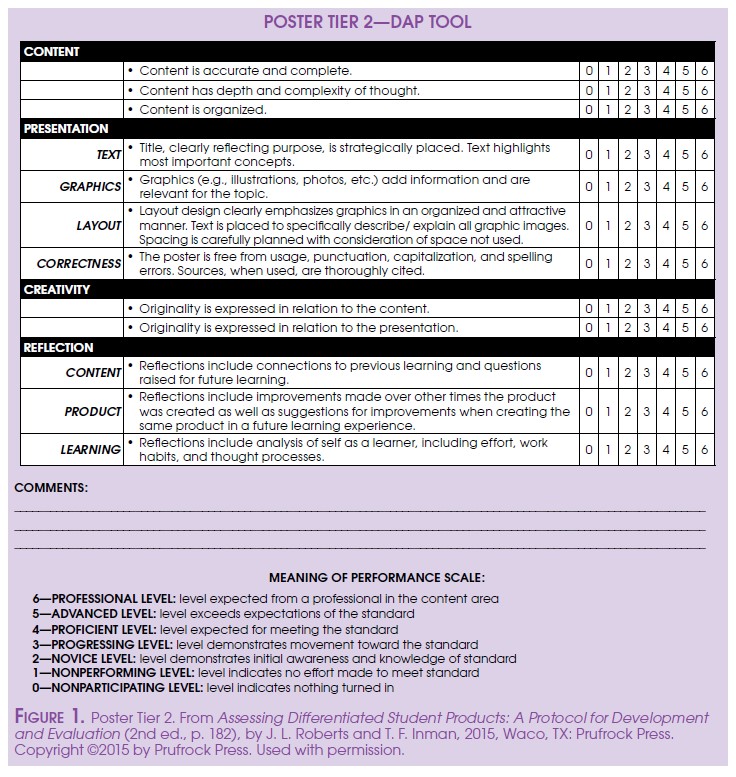
Consistent Components
The DAP Tool sets expectations for students creating products, as all DAP Tools include the same four components—content, presentation, creativity, and reflection. The wording for content, creativity, and reflection remain the same for all DAP Tools, and general language is used so that the criteria apply to all content areas across all grade levels. Presentation is the only component that differs.
Content
The DAP Tool utilizes products to gauge student learning whether the educator is using assessment for learning (formative assessment) or assessment of learning (summative assessment). Content, then, is always the first component. The key considerations guiding students as they develop the content for any product include accuracy, organization, and level of understanding. Is the content accurate? Is it well organized? Has it been thought about in a way that goes beyond a surface understanding? Note the lack of specificity to content. This general wording can apply to a high school student explaining the causes of the Russian Revolution, the middle school student extrapolating on the parts of the cell, or the fourth grader advocating for an increased allowance in a persuasive writing assignment. It is up to the educator to specify the expectations in the actual assignment, which should be distributed alongside the DAP Tool.
Presentation
Presentation is the second of the four components of a DAP Tool, and the only one that changes. The expected aspects or characteristics inherent in a specific product differ from product to product, so the DAP Tool must mirror the product-specific language. For example, as noted in Figure 1, students developing a poster should consider text, graphics, layout, and correctness when designing their product. Students creating a Prezi, however, must attend to the text, multimedia, canvases, delivery, and correctness, while a sculpture should include key elements such as concept, craftsmanship, and elements of design. The guiding characteristics for an essay are structure, elaboration, support, style, and correctness. The presentation portion of the DAP Tool is customized to explain the criteria of the product itself letting the student realize not only what constitutes a poster (or blog or …) but also what is necessary to create an exemplary poster (or blog or…).
Creativity
The third component of a DAP Tool is creativity, and just like content and reflection, stays consistent with each DAP Tool regardless of the product. The need to highlight creativity is great for the individual as well as for the good of society:
The world depends on creative people for contributions in all areas of life, from technology, travel, and medicine, to movies, music, and literature. If that were not reason enough, the most compelling motive for our attention is that we are committed to enabling individuals to live fulfilled lives. Parents and teachers need to know that they have a powerful influence on the development of creativity.
(Robinson, Shore, & Enersen, 2007, p. 77)
When developing a product, creativity can be shown by how students view and develop the content as well as by how they approach and create the product itself. Therefore, questions in this component are twofold: Is the content seen in a new way? Is the presentation done in a new way? Originality and innovation prove key for this component.
Reflection
The fourth and final component of all DAP Tools is reflection, the metacognitive piece of the DAP Tool. Metacognition allows students to think about their learning in the process of developing the product and completing the learning experience. The goal is to make thinking about one’s thinking a habit that promotes learning related to a single learning experience as well as throughout one’s lifetime. Questions relate to:
- content (i.e., What connections can you make between what you have learned by completing this project and previous learning?),
- product (i.e., In what ways could you improve your product when completing this product with a different assignment?), and
- learning (i.e., How did the amount of effort you put into the development of the product affect your learning about the content and creating the product?).
Rating Scale
A second innovation of the DAP Tool is the rating scale itself; it removes the learning ceiling that can be so detrimental, especially to learners with gifts and talents. The seven-level scale includes two levels past proficiency, sending the critical message that improvement is always possible—and necessary for learners to be globally competitive. Figure 2 outlines the levels and their meanings. The word standard (in five of the seven tiers) must be defined before using the DAP Tool, and that definition must be shared with students so that they understand the goal. It is also important that students understand the meaning of professional level. Rarely, if ever, will students create a product that reaches the standard level expected and evaluated by professionals in the field who create and use that product. However, the goal should be to improve each aspect of the product, honing and fine tuning as they strive to create authentic products at increasingly higher levels. Of course, students’ grades should not be gauged by this level; an A should fall in the proficient or advanced levels depending on educator opinion, not the professional level. The professional level will serve as incentive to those students who are accustomed to producing A-level work by only meeting the basic requirements for the grade.
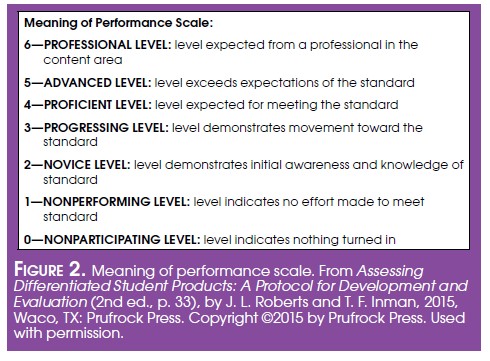
Tiers
In addition to the rating scale that removes the learning ceiling and the four consistent components, DAP Tools also include three distinct tiers for every product. These tiers become hierarchically more sophisticated both in wording and expectation as is noted in Figure 3. Expectations for content progress from being thought about in a way that goes beyond the surface (i.e., Tier 1) to having depth and complexity of thought (i.e., Tier 2) to showing complex understanding and manipulation of content and deep probing of the content (i.e., Tier 3). A student who has very little experience with content (as determined by a preassessment) may not be ready for a Tier 3 assignment regardless of the student’s age or grade level. Likewise, a primary student who has a passion for a subject and enters the classroom with a strong understanding should not use a Tier 1 assignment to create her product; she should be given the opportunity to work at a level commensurate with her knowledge and ability.
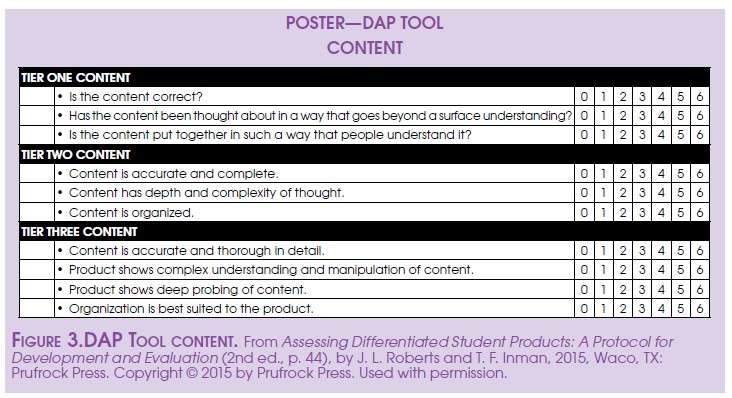
The three tiers encourage differentiation of assessment. A single high school classroom exploring the Constitution, for example, could utilize all three tiers of the Document-Based Question (DBQ) DAP Tool. Those students who have never written a DBQ would use Tier 1; those with experience would use a Tier 2 in order to improve skills; and those with extensive experience would use a Tier 3. Again, the preassessment (this time assessing experience with the specific product) dictates which tier to use. Of course, educators may discover that all students are ready for the same tier.
Sample DAP Tools
Now look at Figure 1 in relation to Figures 4 and 5 to see how the three innovations of consistent components, grading scales, and tiering system function within each tier of the DAP Tool. Note the specificity of language in the presentation of the poster. Experts in the areas that use products provided guidance on these criteria and word choice.
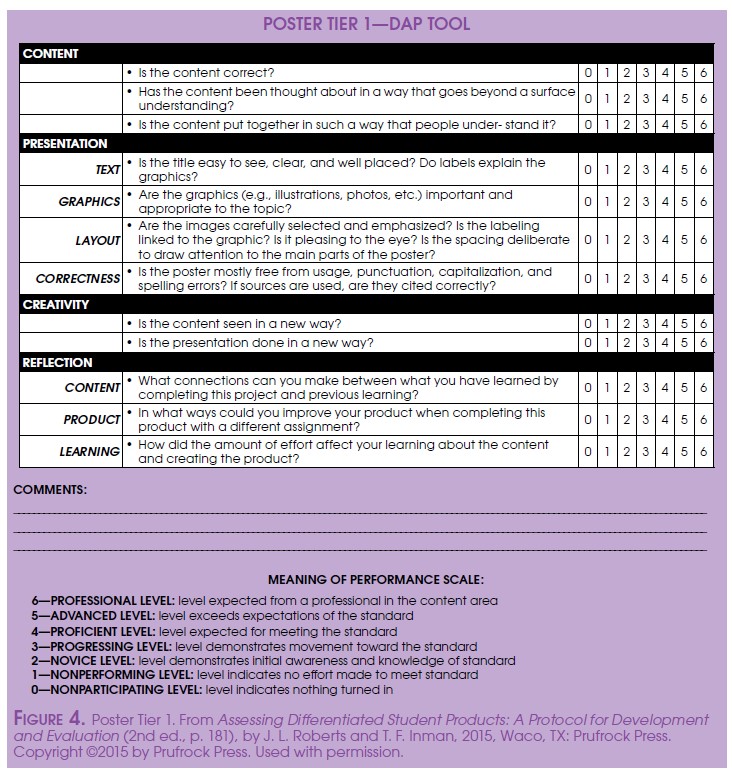
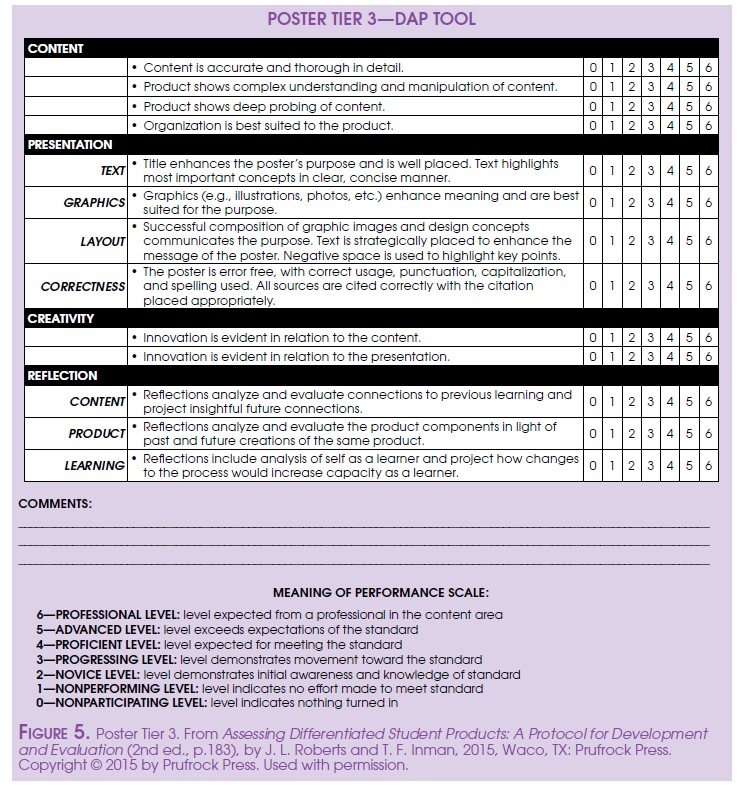
Uses of the DAP Tool
On the most basic level, DAP Tools are rubrics. Educators could use one DAP Tool with the whole class. For instance, a language arts teacher may use the Tier 1 Poetry DAP Tool with all of her third graders as they learn how to write poetry. Another example would be an eighth-grade class studying biomes that will construct models to show what they have learned. Each student will be given a tier appropriate DAP Tool before they begin the model. The DAP Tool then guides them in their creation of the model.
Product differentiation provides more sophisticated use of the DAP Tools. DAP Tools could be housed in a single file drawer or a computer file so that students have easy access to them, allowing extended choice in products. If product choice is approved by the teacher, the students then know they can go to this rubric warehouse to find the tool that will assist them in creating the product of their choice. For example, a sixth-grade teacher may create a menu (or Think-Tac-Toe—they go by many names) to provide appropriately challenging learning experiences for her students as they study Maniac McGee. She may list nine learning choices, each with a different product. Not only does the student have choice of the learning experience on the menu, but, ideally, he would also be able to swap out one product for another. He would simply visit the warehouse for the appropriate DAP Tool. The educator would not hesitate because (a) she is interested more in the what the student is learning than how the student is demonstrating what he has learned, and (b) she knows that the DAP Tools will provide the necessary guidance for a high-quality product.
The most sophisticated use of the DAP Tool is assessment differentiation. A single classroom may have students using Tier 1, Tier 2, and Tier 3. The preassessment may focus on the level of experience students have in creating the products. If the product is brand new to the student, for example, the teacher would use a Tier 1 learning experience. If the student has created the product numerous times, a Tier 1 would provide no challenge. A Tier 2 or 3 experience would be in order. The teacher could design a preassessment that includes content as well as product. By matching tier to experience level and expertise of the students, the educator differentiates expectations and, consequently, assessments. Because students are familiar with the structure, vocabulary, and grading scale of DAP Tools, the assessment is equitable and appropriate.
Grading
DAP Tools work beautifully as both a formative assessment tool and a summative assessment tool. When students receive feedback during the process of creating the product (i.e., formative assessment), they are able to modify, enhance, and hone that product—whether that feedback is content-related or presentation-related. This feedback then actually becomes feed forward:
Feed forward is equally important to learners’ progress: while feedback focuses on current performance (and may simply justify the grade awarded), feed forward looks ahead to the next assignment, offering constructive guidance on how to do better in future work. A combination of the two ensures that assessment has an effective developmental impact on learning (provided the student has the opportunity and support to develop their own evaluative skills in order to use the feedback effectively).
(Gray & Ferrell, 2014, para. 8)
The DAP Tool can also be used formatively by the student as he or she objectively examines each bullet on the DAP Tool in relation to the product being created. Ideally, the student would determine strengths along with areas for improvement. DAP Tools can also be used by peers for formative assessment. In these instances of formative assessments, grades are not typically recorded in the grade book, since the emphasis is on assessment for learning.
Assessment does not equate with grading: “Assessment is the process of finding out where students are relative to key goals at a particular time. Grading is the periodic, somewhat public statement about a student’s performance at designated intervals” (Tomlinson & Imbeau, 2010, p.145). Summative assessment of learning does result in grades in the grade book. When utilizing DAP Tools in this manner, the educator can approach it analytically or holistically. For example, if using the DAP Tool in an analytical way, the teacher might take the total number of descriptors (e.g., 12), and, considering that there will hardly ever be a Level 6 Professional marked on a DAP Tool, multiply that by 5, which equates with Level 5 Advanced. This means that the total possible score would be a 60. If the goal is meeting the standard, then 48 (based on Level 4 which is the proficient) would be the lowest A. The beauty of approaching the grade this way is that the teacher can emphasize important components—such as counting the content section double or doubling the graphics portion on pamphlet because that has been an area of concern or emphasis.
Use caution when transferring any rubric to a grade book. Arter and Chappuis (2006) argued the importance of logic in this endeavor, especially when approaching rubrics using percentages: “Percentages don’t accurately represent level of learning as measured by a rubric” (p. 116). For example, if a 3 is circled on one component, the student is making progress toward the standard (according to the meaning of the performance scale). To simply divide 3 by 5 (not a 6 since it is rarely ever possible), the percentage is 60%. For most traditional scales, a 60% is a D—and that grade certainly does not reflect someone who has almost reached the standard. Arter and Chappuis (2006) suggested the logic rule: “look at the descriptions of the various levels and decide on direct conversions from rubric scores to grades without first converting to percentages” (p. 116). So, for instance, take the earlier example where the DAP Tool had 12 descriptors, and suppose the average score for those descriptors on the five-point scale was 3.75. The percentage would be 75%, a C by most standards. But in the DAP Tool language, this is just .25 from reaching the standard, which is an A. Logic and common sense indicate that a 3.75 is more in the B to B- range. See Creating and Recognizing Quality Rubrics (Arter & Chappuis, 2006) or Assessing Differentiated Student Products (Roberts & Inman, 2015a) for more detailed examples.
Benefits of Using the DAP Tool
The benefits to using a protocol that assists students in developing products as well as educators in assessing them are numerous:
- DAP Tools can be used across all content areas and grade levels.
- DAP Tools were created with input from experts who create the products professionally in order to ensure authentic, 21st century workplace demands.
- Students have a reliable guide to create a product by authentic industry standards.
- Teachers can branch out from their typical product offerings to better meet student interests and strengths. See Figure 6 for a Product List.
- Students can readily have choice in which products they wish to make.
- The language is the same for Content, Creativity, and Reflection for all tiers. Because Presentation is the only one that changes, it is the only component that needs to be taught, and that is only the case when students have not created the product before. This consistency saves valuable learning time.
- The learning ceiling is removed with the grading scale, thus encouraging all students, especially those with gifts and talents, to strive for continuous improvement and growth.
- The three tiers make differentiation of assessment possible.
- Students hone metacognitive skills via the Reflection component. This promotes independence and responsibility for learning.
- A completed DAP Tool can serve as a preassessment in any or all of the four components.
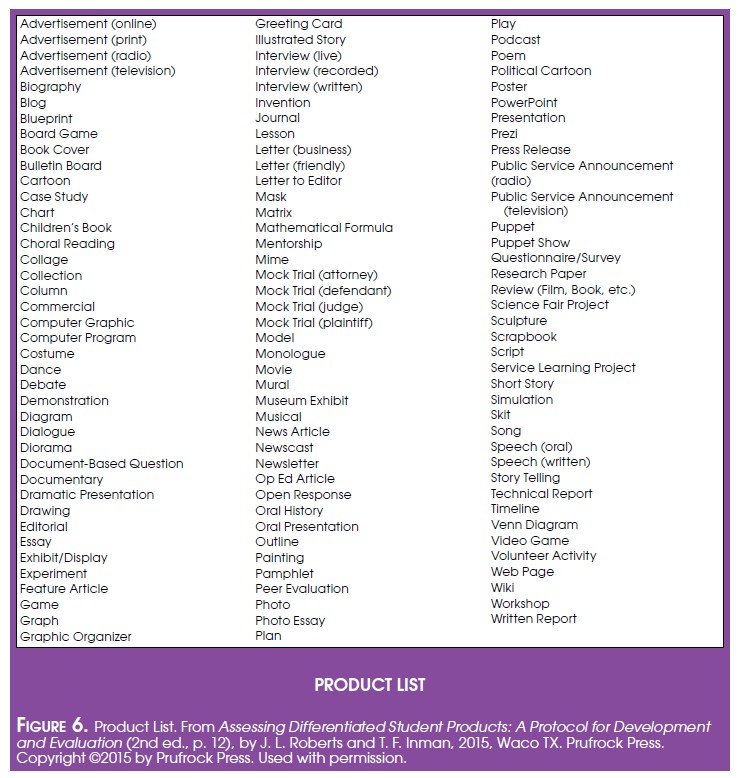
Although there is a time and place for pen-and-paper assessments, product development can help students develop 21st century skills, including critical and creative thinking. Adults create products in their work, so developing high-level products in school prepares students for life beyond school. Products promote excellence and continuous progress in school and beyond.
References
Arter, J. A., & Chappuis, J. (2006). Creating and recognizing quality rubrics. Boston, MA: Pearson Education.
Gray, L., & Ferrell, G. (2014). Feedback and feed forward: Using technology to support learner longitudinal development. Retrieved from http://www.jisc.ac.uk/guides/feedback-and-feed-forward
Roberts, J. L., & Inman, T. F. (2015a). Assessing differentiated student products: A protocol for development and evaluation (2nd ed.). Waco, TX: Prufrock Press.
Roberts, J. L., & Inman, T. F. (2015b). Strategies for differentiating instruction: Best practices for the classroom (3rd ed.). Waco, TX: Prufrock Press.
Robinson, A., Shore, B. M., & Enersen, D. L. (2007). Best practices in gifted education: An evidence-based guide. Waco, TX: Prufrock Press.
Tomlinson, C. A., & Imbeau, M. (2010). Leading and managing a differentiated classroom. Alexandria, VA: Association for Supervision and Curriculum Development.
Tracy Ford Inman, Ed.D., is associate director of The Center for Gifted Studies at Western Kentucky University. She has taught English at the high school and collegiate levels, as well as in summer gifted programs. In addition to writing and co-writing several articles, Tracy has co-authored three books with Julia Roberts through Prufrock Press. They received the Legacy Book Award from the Texas Association for the Gifted and Talented for Strategies for Differentiating Instruction: Best Practices for the Classroom. Tracy co-edited the Legacy Award winning Parenting Gifted Children: The Authoritative Guide From the National Association for Gifted Children.
Julia Link Roberts, Ed.D., Mahurin Professor of Gifted Studies at Western Kentucky University, is Executive Director of the Carol Martin Gatton Academy of Mathematics and Science in Kentucky and The Center for Gifted Studies. Dr. Roberts is on the Executive Committee of the World Council for Gifted and Talented Children and past president of The Association for the Gifted. Her writing focuses on differentiation, gifted education, and advocacy. She received the 2011 Acorn Award as the outstanding professor at a Kentucky 4-year university, the first NAGC David Belin Advocacy Award, the 2012 NAGC Distinguished Service Award, and the 2011 William T. Nallia Award for innovative leadership from the Kentucky Association for School Administrators.






